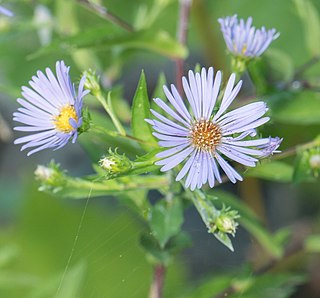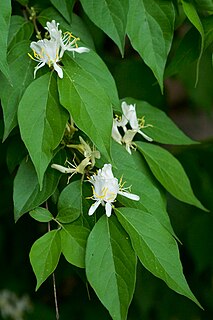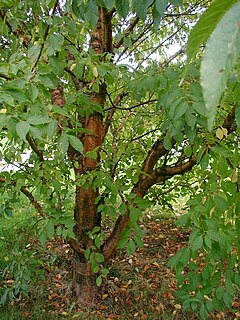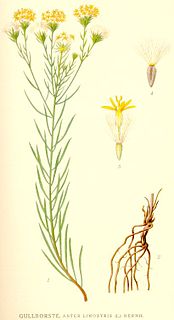
Honeysuckles are arching shrubs or twining vines in the family Caprifoliaceae, native to northern latitudes in North America and Eurasia. Approximately 180 species of honeysuckle have been identified in North America and Eurasia. Widely known species include Lonicera periclymenum, Lonicera japonica and Lonicera sempervirens. L. japonica is an aggressive, highly invasive species considered as a significant pest on the continents of North America, Europe, South America, Australia, and Africa.

Aster is a genus of perennial flowering plants in the family Asteraceae. Its circumscription has been narrowed, and it now encompasses around 180 species, all but one of which are restricted to Eurasia; many species formerly in Aster are now in other genera of the tribe Astereae. Aster amellus is the type species of the genus and the family Asteraceae.

Symphyotrichum novae-angliae, the New England aster, hairy Michaelmas-daisy, or Michaelmas daisy, is a species of flowering plant in the family Asteraceae. It is a perennial, herbaceous plant native to eastern North America, and has been introduced to Europe. The seeds and nectar of this fall-flowering species are important to a wide variety of animals. Numerous cultivars have been developed and the species is a popular garden plant, especially in Europe.

Symphyotrichum is a genus of over 90 species of herbaceous annual and perennial plants in the composite family (Asteraceae) that were formerly treated within the genus Aster. The majority are endemic to North America, but several species also occur in the West Indies, Central and South America, as well as in eastern Eurasia. Many species have been introduced to Europe as garden specimens, most notably New England aster and New York aster.
Bush honeysuckle is a common name for several plants and may refer to:

Symphyotrichum puniceum, commonly known as purplestem aster, red-stalk aster, red-stemmed aster, red-stem aster, or swamp aster, is a perennial herb native to eastern North America. It has also been called early purple aster and meadow scabish.

Lonicera maackii, the Amur honeysuckle, is a species of honeysuckle in the family Caprifoliaceae that is native to temperate western Asia; specifically in northern and western China south to Yunnan, Mongolia, Primorsky Krai in southeastern Siberia, Korea, and, albeit rare there, central and northern Honshū, Japan.

Symphyotrichum cordifolium, commonly known as common blue wood aster, blue wood-aster or heartleaf aster, is a herbaceous perennial plant in the family Asteraceae native to eastern North America.

Prunus maackii, commonly called the Manchurian cherry or Amur chokecherry, is a species of cherry native to Korea and both banks of the Amur River, in Manchuria in northeastern China, and Amur Oblast and Primorye in southeastern Russia. It used to be considered a species of Prunus subg. Padus, but both morphological and molecular studies indicate it belongs to Prunus subg. Cerasus.

Symphyotrichum lateriflorum is a species of flowering plant of the aster family (Asteraceae) native to eastern and central North America. Commonly known as calico aster, starved aster, and white woodland aster, it is a perennial, herbaceous plant that may reach 120 centimeters high and 30 centimeters across. Each flower head has many tiny florets put together into what appear as one.

Richard Otto Maack was a 19th-century Russian naturalist, geographer, and anthropologist. He is most known for his exploration of the Russian Far East and Siberia, particularly the Ussuri and Amur River valleys. He wrote some of the first scientific descriptions of the natural history of remote Siberia and collected many biological specimens, many of which were original type specimens of previously unknown species.

Marumba maackii, the Manchurian hawkmoth, is a species of moth of the family Sphingidae. It is known from the Russian Far East, north-eastern China, North Korea, South Korea and Hokkaido in northern Japan.
Guy L. Nesom is an American writer and botanist.

Symphyotrichum lanceolatum is a species of flowering plant in the family Asteraceae native to North America. Common names include lance-leaved aster, panicled aster, and white panicled aster. It is a perennial, herbaceous plant that may reach 1.5 meters tall or more, sometimes approaching 2 meters. It has a stout rhizome and can spread to form a clonal colony. The species is currently divided into five varieties which have minor differences in appearance and vary in chromosome counts as well as distribution, with some overlap.

Pelodiscus maackii, commonly known as the Amur softshell turtle or the northern Chinese softshell turtle, is a species of turtle in the family Trionychidae. The species is found in the Russian Far East, northeastern China, Korea, and Japan. It is possible that the Japanese populations are the result of ancient introductions by humans. This aquatic species may attain a straight carapace length of 32.5 cm (1.1 ft).

Galatella linosyris is a species of perennial plant from family Asteraceae found in Eastern, Central and Southern Europe. It can also be found in Great Britain, the southern part of Scandinavia and in Asia Minor. The flowers are yellow coloured. The species have stems up to 10–50 centimetres (3.9–19.7 in), with leaves that are lanceolate. The plant does not have ray flowers, only disk florets. It blooms from July to September. The fruits are achenes. The species is under protection in the Czech Republic.

Allium lineare is a Eurasian species of wild onions with a wide range extending from France to Mongolia.
Allium maackii is a species of wild onion native to northeastern Asia. It is found on cliff and steep hillsides at elevations of 200–500 m.

Symphyotrichum oolentangiense, commonly known as skyblue aster or azure aster, is a species of flowering plant in the family Asteraceae, native to eastern North America.

Iris maackii is a species in the genus Iris; it is also in the subgenus Limniris and in the series Laevigatae. It is a rhizomatous perennial, from China and eastern Russia. It has sword-shaped grey-green leaves, and has many branched flowering stems that carry flowers in May that come in various shades of yellow.
















